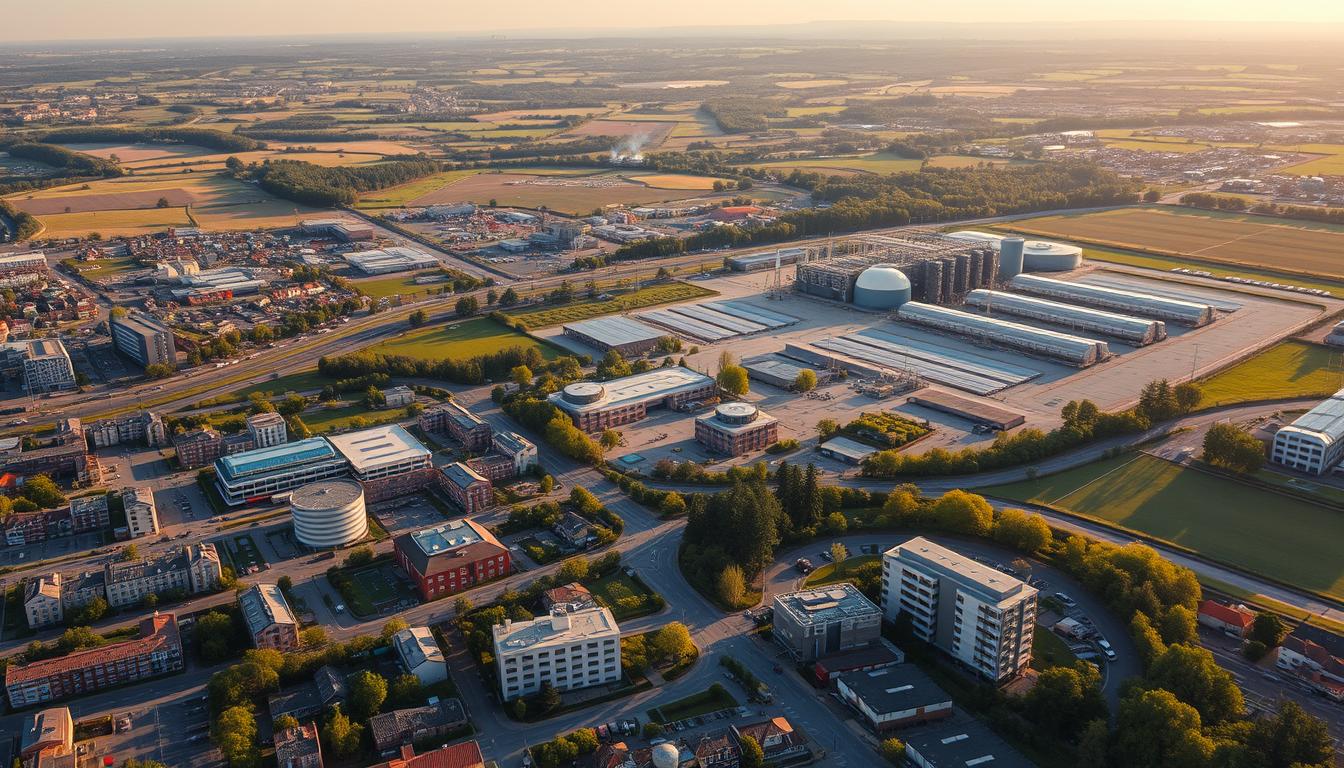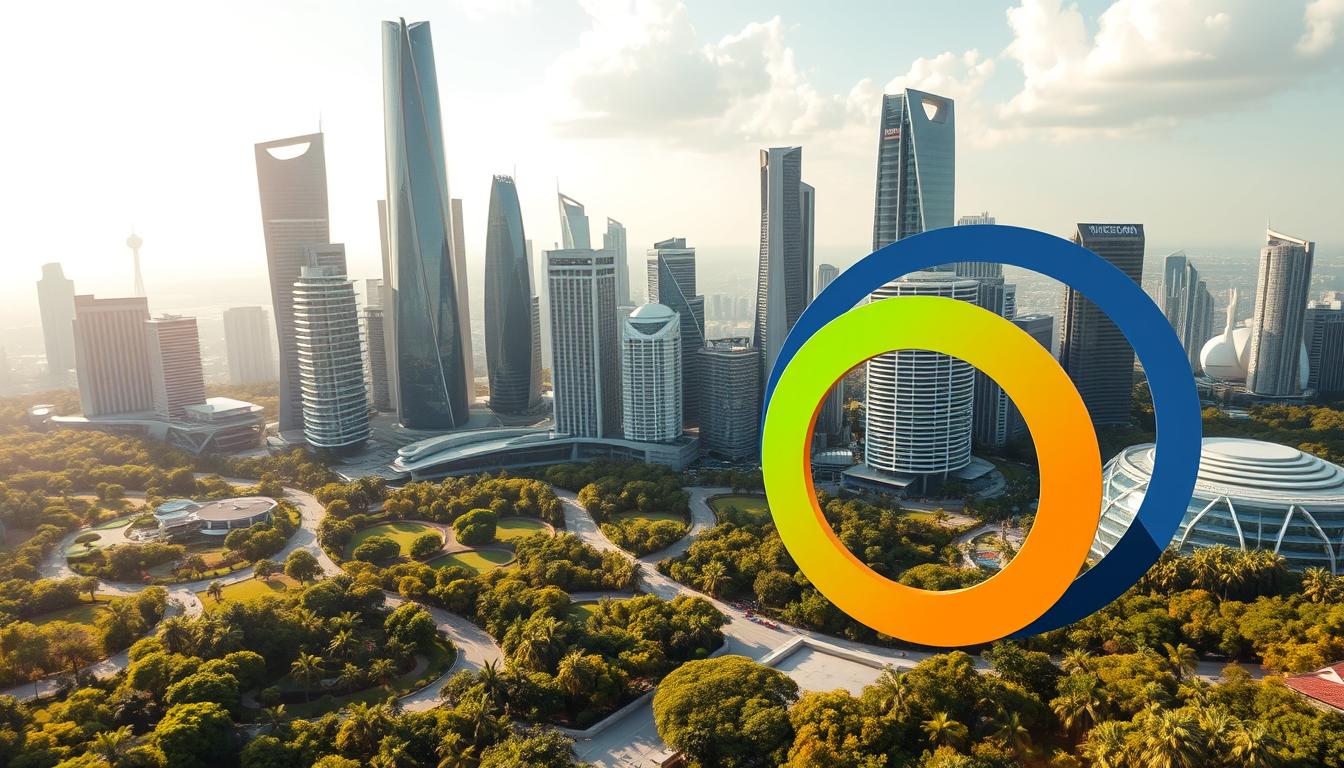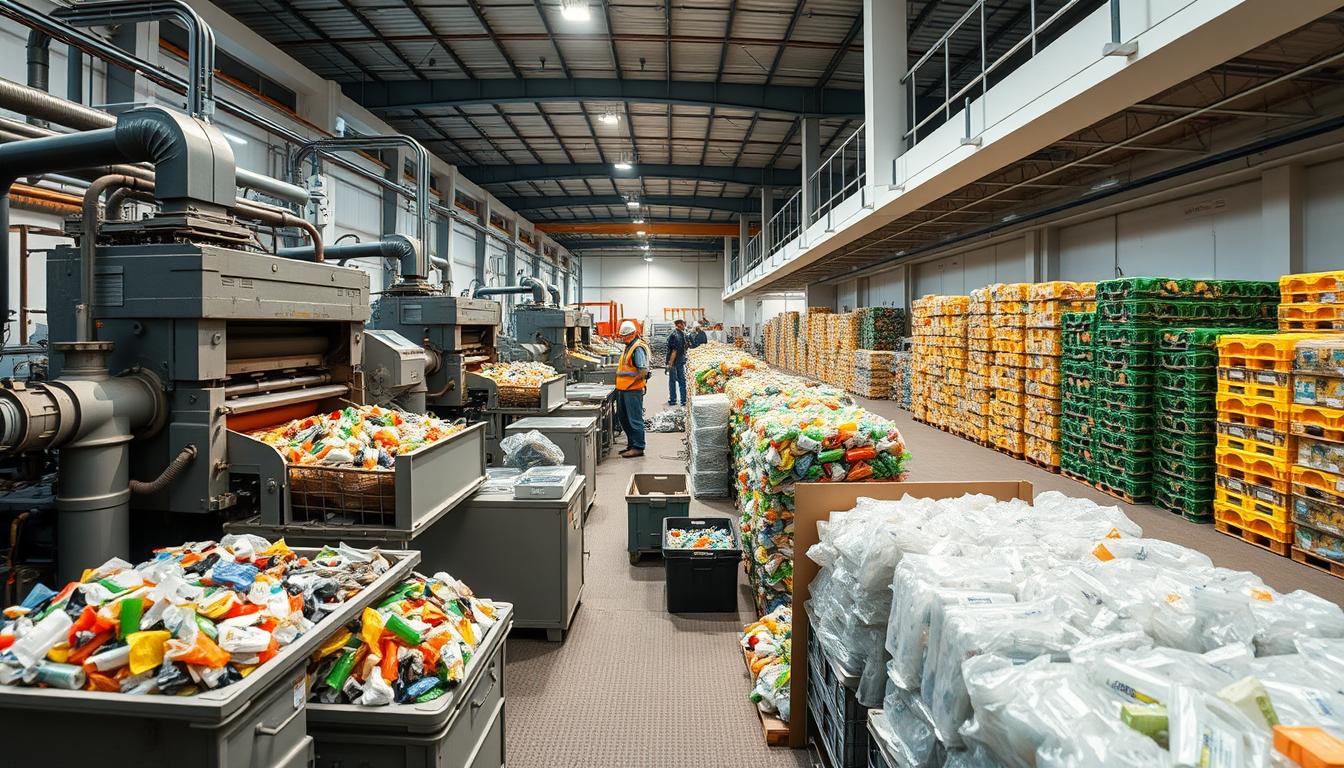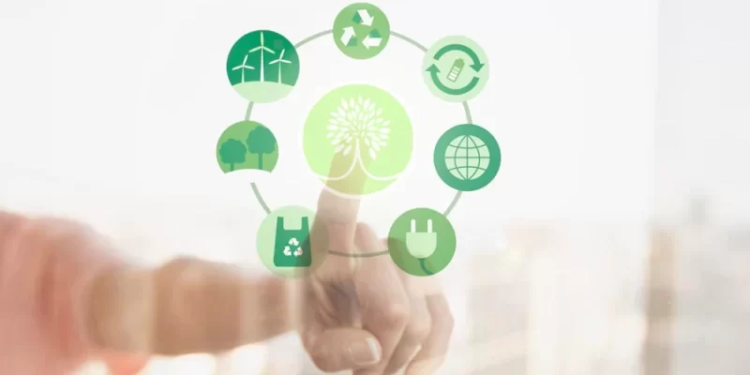Can we shift how the U.S. makes and uses goods so we cut waste, curb pollution, and boost jobs at the same time?
The system I introduce keeps products and materials in use through repair, reuse, remanufacture, recycling, and composting. This approach aims to eliminate waste and pollution while regenerating nature.
Today’s linear take-make-waste model drives resource use, emissions, and biodiversity loss. Faced with climate risks, the world needs practical solutions that redesign products and manage end-of-life materials.

This guide shows three core principles: eliminate waste and pollution, keep items at their highest value, and restore natural systems. You’ll find definitions, real-world practices, policy actions, and a U.S. roadmap.
Expect clear examples of business strategies and technologies that turn end-of-life inputs into new value. These actions complement clean energy shifts by improving material efficiency and product design.
Key Takeaways
- The model keeps materials in circulation to decouple growth from finite resource use.
- Current linear systems harm the planet through pollution and biodiversity loss.
- Three principles—eliminate waste, circulate value, and regenerate nature—drive practical change.
- Businesses and tech can convert end-of-life materials into new markets and resilient supply chains.
- Adopting these solutions strengthens the economy while delivering environmental and social benefits.
What Is a Circular Economy and Why It Matters Today
Today’s production and consumption patterns are shifting toward systems that keep products and materials in continuous use. This approach—called a circular economy—prioritizes sharing, leasing, reusing, repairing, refurbishing, and recycling to extend product lifecycles.
Unlike the linear economy’s take-make-consume-throw pattern, this model reduces disposal and planned obsolescence. Repair, refurbishment, remanufacturing, and recycling keep value in the market and cut resource demand.
Design matters: more than 80% of a product’s environmental impact is decided before manufacturing starts. Smart design choices lower future waste and ease repair or recycling.
Circular strategies shrink waste flows and lessen pressure on the environment and biodiversity loss. They also link to everyday life through sharing services, rental models, and repair networks that help people get more use from durable goods.
In the following sections, we outline core principles, benefits, and practical policies that translate this concept into action across industries and communities.
Core Principles and How the System Works
Design choices set the path for whether products become long-lived assets or waste. Good design avoids toxic inputs, boosts durability, and enables easy disassembly so parts can be repaired or replaced.
Eliminate waste and pollution through design
Start by choosing safer materials and reducing complex composites that block repair. Standardized components and modular layouts make maintenance simple and extend product life.
Circulate products and materials at their highest value
Prioritize repair, reuse, and refurbishment before energy-intensive recycling. Keeping parts in active use preserves value and reduces demand for new raw inputs.

Regenerate nature and restore natural resources
Biological cycles like composting and bio-based production rebuild soil and restore ecosystems. These actions return nutrients and reduce pollution tied to extraction.
System shifts and enablers
The butterfly diagram shows two linked flows: biological reuse and technical remanufacture. Renewable energy and safer material choices power these loops. Policies, materials passports, reverse logistics, and business model shifts accelerate adoption and scale results in the U.S. marketplace.
Benefits for climate, nature, and the economy
Shifting materials strategy can cut emissions, create jobs, and protect habitats across U.S. industries. The gains span climate outcomes, natural systems, and local markets.
Cutting greenhouse gas emissions from materials and production
Material extraction and use drive about 70% of greenhouse gas emissions. Better material efficiency and longer product life could cut emissions in heavy industries by roughly 40% by 2050. Including food systems raises that potential to about 49%.
Reducing biodiversity loss, waste, and pollution
Using fewer raw inputs lowers habitat disruption and biodiversity loss. Less waste and pollution follow when products are designed for repair, reuse, and responsible end-of-life treatment.
Driving jobs, resilience, and competitiveness
New markets for repair, remanufacturing, and services can boost local jobs; the EU estimates up to 700,000 jobs by 2030 from similar measures. Local loops and diverse suppliers increase resilience during supply shocks.
Designing durable products that deliver consumer value
Design matters: over 80% of a product’s environmental impact is set early. Durable, repairable goods offer better lifetime value and lower total cost of ownership, while design standards cut costs and footprints across the system.
Circular economy in practice: sectors, business models, and examples
Practices across industries show how design and business shifts cut waste and boost value. These approaches blend smarter design, better logistics, and new revenue models to keep materials and products useful longer.

Plastics and packaging: reuse, recycling, and redesign
Lightweighting, reusable systems, deposit return, and design for recyclability reduce costs and waste. The EU targets excessive packaging, where Europeans generate about 190 kg per person yearly, by tightening reuse and recycling rules.
Food systems: preventing loss and regenerating soils
Stop loss along the supply chain through better storage, distribution, and treatment. Apeel’s plant-based edible coatings slow water loss and oxidation, cutting single-use plastic wrap and food waste.
Built environment and business models
Design for disassembly, modular construction, and reclaimed-material marketplaces extend building life. In Ghana, entrepreneurs turn recycled plastic into durable housing, showing how local waste can become resilient materials for construction.
Repair, refurbishment, remanufacturing, and product-as-a-service shift incentives toward durability and uptime rather than unit sales. Clear design choices—standard parts, mono-materials, and labeling—make reuse and recycling work at scale. These measures lower material inputs, reduce disposal fees, and improve product performance.
Policies, actions, and the global transition
Policymakers now use design rules and procurement to speed a large-scale transition away from wasteful production models.
Legislation and standards
Ecodesign standards, right-to-repair rules, and packaging reforms make products easier to fix, reuse, or recycle. The EU is updating laws on ecodesign, greenwashing, and waste management to build a climate-neutral economy by 2050.
National climate pledges and circularity
Only 27% of Nationally Determined Contributions include circularity measures as of May 2023. Embedding these steps in NDCs can cut emissions, create jobs, and boost resilience across countries.
Overcoming implementation hurdles
Barriers include limited knowledge, financing gaps for SMEs, and skills shortages. Tracking scope 3 emissions is hard because supply chains and data are opaque.
Public procurement rules, clear labeling, and materials passports can fight greenwashing and reward genuine circular offers. Coordinated action across governments, cities, and industry will scale benefits fast—especially with NDC updates due in 2025.
Roadmap for businesses and communities in the United States
U.S. businesses and towns can adopt concrete steps today to keep materials productive and workplaces thriving.
Design for durability and modularity. Prioritize products that are repairable and easy to disassemble. Use standardized parts so upgrades happen at the component level and life is extended through repair, refurbishment, and remanufacture.
Materials strategies. Choose certified recycled content, safer chemistries, and mono-materials to improve recovery rates. These choices cut resource intensity and make end-of-life processing simpler.
Reverse logistics and partnerships
Set up take-back programs and refurbishment hubs with local recyclers and remanufacturers. Efficient reverse logistics reduce waste and open new revenue from returned goods.
Measure what matters
Track material footprint, product return rates, repair throughput, and lifecycle emissions including scope 3. Measuring these shows real progress and helps reduce emissions while improving resilience.
Business models and consumers. Pilot product-as-a-service offers to align revenue with performance and longevity rather than unit sales. Build consumer trust with clear warranties, repairability scores, and refurbished quality standards.
Finally, invest in workforce training for repair and remanufacturing. Collaborate with municipalities on reuse infrastructure and deconstruction to create local jobs and strengthen community resilience during the transition.
Conclusion
Making products last longer and flow back into use is a practical path to lower emissions and waste. Global material use topped 95.1 billion metric tons in 2019, while overall circularity has fallen in recent years. That gap shows why action matters now.
Better design, repair, and local reuse can cut greenhouse gas emissions by up to 40% for key materials and nearly 49% if food systems improve. Food loss, rising e-waste, and persistent packaging waste also demand new infrastructure and rules.
Businesses, policymakers, and consumers must align: adopt durable products, scale recycling and reuse hubs, and add circular strategies to NDCs to speed climate and resilience gains. Measure progress with clear metrics so improvements become policy and market wins.
FAQ
What does a circular approach mean and why does it matter today?
It means shifting from take-make-waste to systems that keep products and materials in use, reduce pollution, and restore natural resources. This matters because it cuts greenhouse gas emissions, limits biodiversity loss, reduces plastic and other waste, and builds resilient local jobs and supply chains.
What are the core principles that guide this model?
The core ideas are to eliminate waste through better design, keep materials at their highest value through reuse and recycling, and regenerate nature by restoring soils and ecosystems. Businesses and communities apply renewable energy and safer materials to support these goals.
How does design help eliminate waste and pollution?
Smart design chooses durable materials, modular parts, and safer chemicals so products last longer, are repairable, and avoid toxic emissions. Packaging and product redesign reduce material use and prevent pollution across the life cycle.
What practical business models enable keeping products and materials in use?
Repair, refurbishment, remanufacturing, leasing, and product-as-a-service models extend product life and recover value. These approaches lower material demand, cut emissions from production, and create new revenue streams for companies.
How do biological and technical cycles differ in this system?
Biological cycles return organic materials to the environment through composting and soil regeneration. Technical cycles focus on keeping synthetic materials, like metals and plastics, in circulation via reuse, repair, and high-quality recycling.
What role does renewable energy play?
Renewable energy reduces emissions from processing, manufacturing, and recycling. Pairing clean power with efficient material use minimizes the climate impact of production and supports long-term sustainability goals.
How can shifting production methods cut greenhouse gas emissions?
Using fewer virgin materials, optimizing manufacturing, and improving logistics reduces emissions across scope 1–3. Recycling, material substitution, and longer-lived products also lower the carbon footprint of goods.
In what ways does this approach help biodiversity and reduce pollution?
By lowering demand for raw extraction and chemical inputs, the approach protects habitats and reduces runoff, plastic leakage, and air pollution. Regenerative practices in agriculture restore soils and support diverse ecosystems.
What examples exist in plastics and packaging?
Solutions include refill systems, reusable containers, redesign to reduce material use, and advanced recycling that produces higher-quality secondary plastics. Brands like Loop and ecosystem initiatives show how reuse models scale.
How can food systems benefit from these practices?
Preventing food loss, composting organic waste, adopting regenerative farming, and improving supply-chain logistics cut emissions and restore soil health, increasing resilience and reducing fertilizer reliance.
What changes are happening in the built environment?
The sector is using reclaimed timber, recycled steel, and modular designs that enable deconstruction. Cities adopt circular procurement and material passports to track and reuse building components.
How do policy and standards support the transition?
Ecodesign rules, right-to-repair laws, packaging regulations, and incentives for recycled content drive better products and create market certainty. National climate pledges increasingly include material- and waste-related measures.
What obstacles do businesses face and how can they be overcome?
Common challenges include finance for small and medium enterprises, skills gaps, and tracking scope 3 emissions. Solutions include public-private funding mechanisms, workforce training, standardized metrics, and better data systems.
How should U.S. businesses measure progress?
Track material footprints, product lifetimes, reuse rates, recycling quality, and associated emissions. Standard metrics and transparent reporting help companies set targets and demonstrate performance to investors and consumers.
What immediate actions can companies and communities take?
Start with product redesign for durability, set up take-back or repair services, prioritize recycled content, and partner with local recycling and composting infrastructure. These steps reduce waste, cut costs, and create local jobs.





